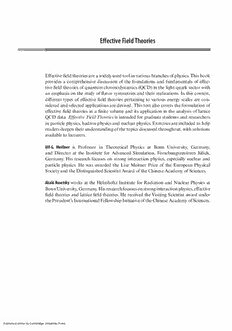Table Of ContentEffectiveFieldTheories
Effectivefieldtheoriesareawidelyusedtoolinvariousbranchesofphysics.Thisbook
provides a comprehensive discussion of the foundations and fundamentals of effec-
tivefieldtheoriesofquantumchromodynamics(QCD)inthelightquarksectorwith
anemphasisonthestudyofflavorsymmetriesandtheirrealizations.Inthiscontext,
different types of effective field theories pertaining to various energy scales are con-
sideredandselectedapplicationsaredevised.Thistextalsocoverstheformulationof
effective field theories in a finite volume and its application in the analysis of lattice
QCDdata.EffectiveFieldTheoriesisintendedforgraduatestudentsandresearchers
inparticlephysics,hadronphysicsandnuclearphysics.Exercisesareincludedtohelp
readersdeepentheirunderstandingofthetopicsdiscussedthroughout,withsolutions
availabletolecturers.
Ulf-G. Meißner is Professor in Theoretical Physics at Bonn University, Germany,
and Director at the Institute for Advanced Simulation, Forschungszentrum Jülich,
Germany. His research focuses on strong interaction physics, especially nuclear and
particle physics. He was awarded the Lise Meitner Prize of the European Physical
SocietyandtheDistinguishedScientistAwardoftheChineseAcademyofSciences.
AkakiRusetsky works at the Helmholtz Institute for Radiation and Nuclear Physics at
BonnUniversity,Germany.Hisresearchfocusesonstronginteractionphysics,effective
fieldtheoriesandlatticefieldtheories.HereceivedtheVisitingScientistawardunder
thePresident’sInternationalFellowshipInitiativeoftheChineseAcademyofSciences.
Published online by Cambridge University Press
Published online by Cambridge University Press
Effective Field Theories
ULF-G.MEIßNER
BonnUniversity
and
ForschungszentrumJülich
AKAKIRUSETSKY
BonnUniversity
Published online by Cambridge University Press
UniversityPrintingHouse,CambridgeCB28BS,UnitedKingdom
OneLibertyPlaza,20thFloor,NewYork,NY10006,USA
477WilliamstownRoad,PortMelbourne,VIC3207,Australia
314–321,3rdFloor,Plot3,SplendorForum,JasolaDistrictCentre,NewDelhi–110025,India
103PenangRoad,#05–06/07,VisioncrestCommercial,Singapore238467
CambridgeUniversityPressispartoftheUniversityofCambridge.
ItfurtherstheUniversity’smissionbydisseminatingknowledgeinthepursuitof
education,learning,andresearchatthehighestinternationallevelsofexcellence.
www.cambridge.org
Informationonthistitle:www.cambridge.org/9781108476980
DOI:10.1017/9781108689038
©CambridgeUniversityPress2022
Thispublicationisincopyright.Subjecttostatutoryexception
andtotheprovisionsofrelevantcollectivelicensingagreements,
noreproductionofanypartmaytakeplacewithoutthewritten
permissionofCambridgeUniversityPress.
Firstpublished2022
AcataloguerecordforthispublicationisavailablefromtheBritishLibrary.
ISBN978-1-108-47698-0Hardback
Additionalresourcesforthispublicationatwww.cambridge.org/effectivefieldtheories.
CambridgeUniversityPresshasnoresponsibilityforthepersistenceoraccuracyof
URLsforexternalorthird-partyinternetwebsitesreferredtointhispublication
anddoesnotguaranteethatanycontentonsuchwebsitesis,orwillremain,
accurateorappropriate.
Published online by Cambridge University Press
Contents
Preface pageix
1 BasicConcepts 1
1.1 Introduction 1
1.2 Warm-up:EffectiveTheoryforScatteringonthePotentialWell 2
1.3 IntegratingoutaHeavyScale:aModelatTreeLevel 13
1.4 TheModelatTreeLevel:Path-IntegralFormalism 17
1.5 EquationsofMotionandFieldRedefinitions 18
1.6 LightParticleMassatOneLoop 23
1.7 MatchingoftheQuarticCouplingatOneLoop 28
1.8 DependenceoftheEffectiveCouplingsontheHeavyMass 35
1.9 DecouplinginDifferentRenormalizationSchemes 38
1.10 FloatingCutoff 42
1.11 EmergentSymmetries 46
1.12 Trivialityoftheϕ4-Theory 52
1.13 RelevantDegreesofFreedomatLowMomenta 59
1.14 ConstructionPrinciplesofanEFT 60
1.15 LiteratureGuide 61
References 62
2 NonrelativisticEffectiveTheories 66
2.1 Introduction 66
2.2 Foldy–WouthuysenTransformation 67
2.3 ConstructionoftheNonrelativisticLagrangianforaScalarField 73
2.4 Symmetries 76
2.5 PerturbationTheory,MatchingandtheEffectiveRangeExpansion 81
2.6 Nucleon–NucleonScattering:theCaseofaLargeScatteringLength 91
2.7 RelativisticKinematics:Two-ParticleProcesses 94
2.8 CuspsinThree-ParticleDecays 99
2.9 DimersandtheFaddeevEquation 105
2.10 EfimovEffect 116
2.11 IncludingVirtualPhotonsinNonrelativisticTheories 121
2.12 SpectrumandDecaysofHadronicAtoms 143
2.13 LiteratureGuide 153
References 154
v
Published online by Cambridge University Press
vi Contents
3 Symmetries 161
3.1 Introduction 161
3.2 Euler–HeisenbergLagrangian 162
3.3 InteractionofLong-WavelengthPhotonswithAtoms 169
3.4 QCDFactsheet 170
3.5 ChiralSymmetryinQCD 174
3.6 WardIdentities 176
3.7 TheTriangleAnomaly 180
3.8 Anomalies:Point-SplitTechnique 188
3.9 FujikawaDeterminant 192
3.10 Non-AbelianAnomalies 197
3.11 Atiyah–SingerIndexTheorem 204
3.12 ChiralSymmetryandAnomaliesontheLattice 205
3.13 TraceAnomaly,DimensionalTransmutationandtheProtonMass 219
3.14 Low-EnergySpectrumofQCD:GoldstoneTheorem 224
3.15 Vafa–WittenTheorem 236
3.16 QuarkMassDependenceofHadronMasses 238
3.17 Soft-PionTechnique 242
3.18 Witten–VenezianoFormula 245
3.19 AnomalyMatching 247
3.20 SymmetriesandSpectrumof(Partially)QuenchedQCD 252
3.21 LiteratureGuide 256
References 257
4 Low-EnergyEffectiveFieldTheoryofQCD 263
4.1 Introduction 263
4.2 TheS-MatrixofCompositeParticles 265
4.3 Weinberg’sTheorem 275
4.4 Theσ-Model 277
4.5 Theσ-ModelwithNucleons 291
4.6 NonlinearRealizationofChiralSymmetry 299
4.7 ChiralPerturbationTheoryintheMesonSector:Lagrangianand
GeneratingFunctional 304
4.8 Tree-LevelCalculations 309
4.9 ChiralPerturbationTheoryatOneLoop 316
4.10 ChiralLagrangianwithNucleons 337
4.11 ConsistentFormulationsofBaryonChiralPerturbationTheory 346
4.12 TheoreticalUncertainties 370
4.13 TheMeaningofLow-EnergyTheorems 373
4.14 IncludingElectromagneticandWeakInteractions 378
4.15 SplittingoftheStrongandtheElectromagneticInteractions 402
4.16 Wess–Zumino–WittenEffectiveAction 408
4.17 Theη0-MesonandLarge-NcChPT 413
4.18 InvarianceoftheChPTLagrangian 421
Published online by Cambridge University Press
vii Contents
4.19 PartiallyQuenchedChPT 424
4.20 Theθ-Term,StrongCPViolationandAxions 431
4.21 LiteratureGuide 448
References 450
5 EffectiveTheoriesinaFiniteVolume 466
5.1 Introduction 466
5.2 TheMassofaStableParticleinaFiniteVolume 467
5.3 ScatteringStates:theLüscherEquation 476
5.4 MovingFrames,AngularMomentumandSpin 487
5.5 TwistedBoundaryConditions 499
5.6 Two-ParticleDecays 506
5.7 MultiparticleSystems:PerturbativeExpansionfortheEnergyLevels 513
5.8 Three-ParticleQuantizationCondition 522
5.9 Three-ParticleDecaysontheLattice 528
5.10 PhotonsinaFiniteVolume 533
5.11 TheChiralLimitinaFiniteVolume 542
5.12 LiteratureGuide 556
References 558
6 Exercises 565
AppendixA NotationsandConventions 599
A.1UnitsandMetric 599
A.2PauliMatrices 600
A.3Gell–MannMatrices 601
A.4DiracMatrices 602
A.5IsospinandSU(3)FlavorSymmetry 602
A.6SphericalHarmonics 603
A.7Clebsch–GordanCoefficients 604
A.8BesselFunctions 605
Index 606
Published online by Cambridge University Press
Published online by Cambridge University Press
Preface
Effectivefieldtheories(EFTs)havebecomeapremiertoolinmanybranchesoftheoret-
icalphysics,inparticularinnuclear,hadronicandparticlephysics.Itistheaimofthis
book to present the foundations and applications of such an approach to the strong
interactionswithintheverysuccessfulStandardModelofparticlephysics.Although
wecoverawidevarietyoftopics,weconcentrateonapplicationsinhadronicandpar-
ticlephysics.Furthermore,ouraimisnottoconsiderallpossibleEFTsinthesefields,
but rather to discuss the physics related to the many fascinating phenomena emerg-
ing in the light quark sector of Quantum Chromodynamics. We stress that we put a
strongemphasisonthebasicsandthefoundationsoftheseEFTsandonlyworkout
a few assorted applications. All this is based on a thorough discussion of the perti-
nentsymmetriesandtheirrealizations,whichisonefundamentalcornerstoneofany
EFT.NotableomissionsareheavyquarkEFTs,thewidefieldofnuclearphysics(with
theexceptionoftheso-calledpionlessnuclearEFTcoveredhere)andalsotheStand-
ardModelEFT,whichhasgainedprominenceinrecentyears.Wheneverpossible,we
refer to appropriate books, reviews or papers. In any case, this book should enable
the reader to work out an appropriately tailored EFT for any physical system under
consideration.Furthermore,whenevernecessary,weexplaintheunderlyingquantum
fieldtheoretical(QFT)toolsthatarerequiredtomasterEFTs.However,wehavenot
madeanyattempttoprovideaself-containedQFTbook,asmanyexcellentbookson
thissubjectareavailable.
Thegenesisofthisbookisquiteinteresting.Itwasoriginallystartedbyoneofthe
authors(UGM)atForschungszentrumJülichmorethantwodecadesagobutcametoa
haltwhenhemovedtoBonnUniversityandtookoveranumberofadministrativeposi-
tions.Inaway,thiswasfortunate,asovertheyearswefrequentlylecturedtogetheron
coursesinTheoreticalHadronPhysics,AdvancedTheoreticalHadronPhysics,Effec-
tiveFieldTheoriesandthelike,whichallowedustosharpenourviewonthesetopics,
ultimatelyleadingtothebookinitspresentform.
Many colleagues have contributed to our understanding of the topics discussed
here, in particular Véronique Bernard, Bugra Borasoy, Gilberto Colangelo, Michael
Döring, Gerhard Ecker, Evgeny Epelbaum, Jambul Gegelia, Feng-Kun Guo, Hans-
WernerHammer,MartinHoferichter,BarryHolstein,MishaIvanov,NorbertKaiser,
Joachim Kambor, Bastian Kubis, Valery Lyubovitskij, Maxim Mai, Ferenc Nieder-
mayer, Jin-Yi Pang, Fernando Romero-López, Jacobo Ruiz de Elvira, Chien-Yeah
SengandJia-JunWu.WeareespeciallygratefultoJürgGasserandHeiriLeutwyler
forsharingtheirdeepinsights.
ix
https://doi.org/10.1017/9781108689038.001 Published online by Cambridge University Press
x Preface
WeespeciallythankFeng-Kun-GuoandBernardMetschforacarefulreadingofthe
manuscript,Hans-WernerHammerforusefulremarksonEfimovphysicsandFabian
Müllerforhelpwiththeexercises.Theyshouldnot,however,bemaderesponsiblefor
anyerror.
We are grateful for the support and patience of Simon Capelin, Sarah Lambert,
Henry Cockburn, Vince Higgs and Arya Thampi from Cambridge University Press
whowereinstrumentalinmakingthisbookpossible.
WearealsogratefulforthehospitalityextendedbytheInstituteforTheoreticalPhys-
icsandtheInstituteofHigh-EnergyPhysicsoftheChineseAcademyofSciences,the
SchoolofPhysicsofPekingUniversityinBeijing,China,andtheInstituteforNuclear
TheoryatSeattle,Washington,USA,wherepartsofthisbookwerewritten.
This book could not have been completed without generous funding from the
Deutsche Forschungsgemeinschaft, the Chinese Academy of Sciences, Volkswagen-
Stiftung,EuropeanResearchCouncilandShotaRustaveliNationalScienceFounda-
tionofGeorgia.
https://doi.org/10.1017/9781108689038.001 Published online by Cambridge University Press

